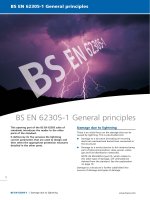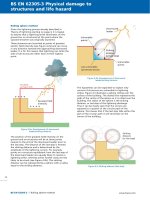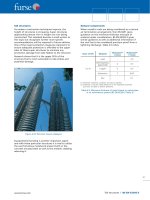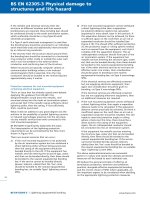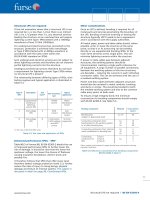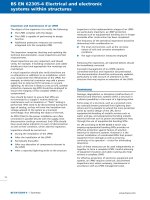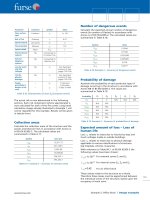Bsi bs en 00720 2 1997
Bạn đang xem bản rút gọn của tài liệu. Xem và tải ngay bản đầy đủ của tài liệu tại đây (183.55 KB, 20 trang )
BRITISH STANDARD
Transportable gas
cylinders Ð
Gases and gas mixtures
Part 2. Determination of flammability
and oxidizing ability of gases and gas
mixtures
The European Standard EN 720-2 : 1996 has the status of a
British Standard
ICS 71.100.20; 75.160.30
NO COPYING WITHOUT BSI PERMISSION EXCEPT AS PERMITTED BY COPYRIGHT LAW
|
|
|
|
|
|
|
|
|
|
|
|
|
|
|
|
|
|
|
|
|
|
|
|
|
|
|
|
|
|
|
|
|
|
|
|
|
|
|
|
|
|
|
|
|
|
|
|
|
|
|
|
|
|
|
|
|
|
|
|
|
|
|
|
|
|
|
|
|
|
|
|
|
|
|
|
|
|
|
|
|
|
|
|
|
|
|
|
|
|
|
|
|
|
|
|
|
|
|
|
|
|
|
|
|
|
|
|
|
|
|
|
|
|
|
|
|
|
|
|
|
|
|
|
|
|
|
|
|
BS EN
720-2 : 1997
BS EN 720-2 : 1997
Committees responsible for this
British Standard
The preparation of this British Standard was entrusted to Technical Committee
PVE/3, Gas containers, upon which the following bodies were represented:
Aluminium Extruders' Association
Aluminium Federation
British Compressed Gases Association
British Fire Consortium
British Gas plc
British Iron and Steel Producers' Association
British Soft Drinks Association Ltd.
Engineering Equipment and Materials Users' Association
Fire Extinguishing Trades Association
Health and Safety Executive
Home Office
Institution of Chemical Engineers
LP Gas Association
Marine Safety Agency
Ministry of Defence
National Engineering Laboratory
National Physical Laboratory
Safety Assessment Federation Ltd.
Safety Equipment Association
Tube Investments Chesterfield Tube Co. Ltd.
Tubes Investments Limited
The following bodies were also represented in the drafting of the standard, through
subcommittees and panels:
British Association of Breathing Apparatus Service Engineers
Department of Health
This British Standard, having
been prepared under the
direction of the Engineering
Sector Board, was published
under the authority of the
Standards Board and comes into
effect on
15 March 1997
BSI 1997
Amendments issued since publication
Amd. No.
The following BSI references
relate to the work on this
standard:
Committee reference PVE/3
Draft for comment 92/73889 DC
ISBN 0 580 26784 9
Date
Text affected
BS EN 720-2 : 1997
Contents
Committees responsible
National foreword
Foreword
Text of EN 720-2
BSI 1997
Page
Inside front cover
ii
2
3
i
BS EN 720-2 : 1997
National foreword
This British Standard has been prepared by Technical Committee PVE/3 and is the
English language version of EN 720-2 : 1996 Transportable gas cylinders Ð Gases and
gas mixtures Part 2. Determination of flammability and oxidizing ability of gases
and gas mixtures published by the European Committee for Standardization (CEN).
EN 720-2 was produced as a result of international discussions in which the United
Kingdom took an active part.
There has previously been no British Standard directly equivalent to this standard.
Cross-reference
International Standard
ISO 4589
Corresponding British Standard
BS 2782 Methods of testing plastics
Part 1 Thermal properties
Method 141 : 1986 Determination of flammability of oxygen
index
Compliance with a British Standard does not of itself confer immunity
from legal obligations.
Summary of pages
This document comprises a front cover, an inside front cover, pages i and ii, the
EN title page, pages 2 to 14, an inside back cover and a back cover.
ii
BSI 1997
EN 720-2
EUROPEAN STANDARD
NORME EUROPÊENNE
EUROPẰISCHE NORM
July 1996
ICS 71.100.20; 75.160.30
Descriptors: Gas, gas mixtures, flammable gases, classifications, flammability testing, oxidation tests, computation, flammability, toxicity,
tables (data)
English version
Transportable gas cylinders Ð Gases and gas mixtures
Part 2: Determination of flammability and oxidizing ability of gases
and gas mixtures
Bouteilles aÁ gaz transportables Ð Gaz et meÂlanges
de gaz Ð Partie 2: DeÂtermination du potentiel
d'inflammabilite et d'oxydation des gaz et meÂlanges
de gaz
Ortsbewegliche Gasflaschen Ð Gase und
Gasgemische Ð Teil 2: Bestimmung der
Brennbarkeit und des OxidationsvermoÈgens von
Gasen und Gasgemischen
This European Standard was approved by CEN on 1996-02-10. CEN members are
bound to comply with the CEN/CENELEC Internal Regulations which stipulate the
conditions for giving this European Standard the status of a national standard
without any alteration.
Up-to-date lists and bibliographical references concerning such national standards
may be obtained on application to the Central Secretariat or to any CEN member.
This European Standard exists in three official versions (English, French, German).
A version in any other language made by translation under the responsibility of a
CEN member into its own language and notified to the Central Secretariat has the
same status as the official versions.
CEN members are the national standards bodies of Austria, Belgium, Denmark,
Finland, France, Germany, Greece, Iceland, Ireland, Italy, Luxembourg, Netherlands,
Norway, Portugal, Spain, Sweden, Switzerland and United Kingdom.
CEN
European Committee for Standardization
Comite EuropeÂen de Normalisation
EuropaÈisches Komitee fuÈr Normung
Central Secretariat: rue de Stassart 36, B-1050 Brussels
1996 Copyright reserved to CEN members
Ref. No. EN 720-2 : 1996 E
Page 2
EN 720-2 : 1996
Foreword
This European Standard has been prepared by
Technical Committee CEN/TC 23, Transportable gas
cylinders, the secretariat of which is held by BSI.
This European Standard is a two Part standard,
belonging to a series of standards relating to gases and
gas mixtures:
Part 1. Properties of single component gases;
Part 2. Determination of flammability and
oxidizing ability of gases and gas mixtures.
ISO Standard ISO 10156 was used as a base document.
This European Standard shall be given the status of a
national standard, either by publication of an identical
text or by endorsement, at the latest by January 1997,
and conflicting national standards shall be withdrawn
at the latest by January 1997.
According to the CEN/CENELEC Internal Regulations,
the national standards organizations of the following
countries are bound to implement this European
Standard: Austria, Belgium, Denmark, Finland, France,
Germany, Greece, Iceland, Ireland, Italy, Luxembourg,
Netherlands, Norway, Portugal, Spain, Sweden,
Switzerland and the United Kingdom.
Contents
Foreword
1
Scope
2
Normative references
3
Definitions and symbols
4
Flammability of gases and gas
mixtures in air
5
Oxidizing ability of gases and gas
mixtures
Annexes
A
(normative) Lower flammability limit
(Li), in air, of pure gases classified by
group
B
(informative) Example of alternative
equipment for the determination of
flammability limits of gases at
atmospheric pressure and ambient
temperature
Page
2
3
3
3
4
9
10
13
BSI 1997
Page 3
EN 720-2 : 1996
3.2 Symbols
1 Scope
This standard identifies test and calculation methods
for the determination of flammability and oxidizing
ability of gases and gas mixtures. The first test method
determines whether or not a gas is flammable in air.
The second test method determines if a gas or gas
mixture has a greater or lesser oxidizing ability than
that of air.
The calculation method uses the characteristics of the
pure substances, of which the mixture is composed, to
determine the characteristics of the mixture.
The results of the methods of determination, described
in this standard, are intended to assist in the selection
of safe gas cylinder valve outlet connections.
Ai
A9i
Bi
Ci
Fi
Ii
Ki
Li
2 Normative references
This European Standard incorporates by dated or
undated references, provisions from other publications.
These normative references are cited at the
appropriate places in the text and the publications are
listed hereafter. For dated references, subsequent
amendments to or revisions of any of these
publications apply to this European Standard only
when incorporated in it by amendment or revision. For
undated references the latest edition of the publication
referred to applies.
ISO 4589
p
Tci
xi
yi
Plastics Ð Determination of flammability
by oxygen index
3 Definitions and symbols
3.1 Definitions
For the purposes of this standard, the following
definitions apply.
3.1.1 gas or gas mixture flammable in air
A gas or gas mixture, which will ignite, in air, at
atmospheric pressure and a temperature of 20 ÊC.
3.1.2 lower flammability limit in air
The minimum content of a gas or gas mixture, in air, at
which the gas or gas mixture will ignite. This limit is
determined at atmospheric pressure and a temperature
of 20 ÊC.
3.1.3 gas or gas mixture less oxidizing than air
A gas or gas mixture which is not able, at atmospheric
pressure, to support the combustion of substances,
which are flammable in air.
BSI 1997
n
Ar
CF4
C3F8
CH4
CO2
He
H2
Kr
Ne
N2
N2O
O2
SF6
SO2
Xe
Molar fraction of a flammable gas in a
mixture of gases.
Equivalent content of a flammable gas.
Molar fraction of an inert gas in a mixture
of gases.
Coefficient of oxygen equivalency.
ith flammable gas in a gas mixture.
ith inert gas in a gas mixture.
Coefficient of equivalency of an inert gas
relative to nitrogen.
Lower flammability limit, in air, of a
flammable gas.
Number of flammable gases in a gas
mixture.
Number of inert gases in a gas mixture.
Maximum flammable gas content for which
a mixture of the flammable gas in nitrogen
is not flammable in air.
Concentration of a highly oxidizing gas.
Minimum concentration of an oxidizing
combustion gas, in a mixture with nitrogen,
which will support combustion of a test
piece, having a limiting oxygen index equal
to 21 %.
Argon.
Carbon tetrafluoride.
Octofluoropropane.
Methane.
Carbon dioxide.
Helium.
Hydrogen.
Krypton.
Neon.
Nitrogen.
Nitrous oxide.
Oxygen.
Sulfur hexafluoride.
Sulfur dioxide.
Xenon.
Page 4
EN 720-2 : 1996
4 Flammability of gases and gas mixtures
in air
4.1 General
It is necessary to identify gases and gas mixtures
which are flammable. Such gases and gas mixtures
have flammable limits in air. The following subclauses
outline test and calculation methods for determining
whether a gas or gas mixture is considered to be
flammable. In cases where the test result is different to
that achieved by calculation, the test result shall take
precedence.
4.2 Test method
The gas is mixed, in the desired proportions, with air.
An ignition energy is applied, from an electric arc
across two electrodes (e.g. a spark plug).
4.3 Equipment
The equipment includes (see figure l):
± a mixing apparatus;
± a chamber in which the reaction takes place;
± an ignition system;
± systems of analysis to test the gas compositions.
4.3.1 Reaction chamber (see figure 1)
The reaction chamber shall be made of suitable
material, of adequate thickness (e.g. borosilicate glass,
5 mm thick), having an inside diameter of at
least 50 mm and a length of at least 5 times the
diameter.
Vent valve
Gas vent to atmosphere
Reactor chamber
length 1m
i.d. 50mm
Analysis point 2
Mixing apparatus
Thermocouples
Flowmeter
Spark plug
Safety device
(pressure relief valve)
Test gas
Analysis point 1
Compressed air
Purging valve
Figure 1. Example of equipment for the determination of flammability limits of gases, at
atmospheric pressure and ambient temperature
BSI 1997
Page 5
EN 720-2 : 1996
The reaction chamber shall incorporate the following:
± an ignition spark plug located approximately 50
mm from the base of the chamber;
± an inlet for the gas mixture being tested;
± a purging valve, at the bottom;
± two thermocouples, one close to the spark plug
and the other close to the top of the chamber. The
purpose of these thermocouples is to detect flame
propagation;
± a safety device (preferably located close to the
spark plug), to minimize the risk of destruction of
the chamber, in the event of an explosion;
± a vent valve, at the top, to atmosphere.
The reaction chamber is positioned inside a ventilated
protective enclosure, one side of which has a window
made of high strength transparent material. In a dark
room, this window will enable detection of an ignition
by an experienced observer. This visual detection is
not possible with the almost colourless flames of
hydrogen mixtures, for which thermocouples should be
used.
4.3.2 Flow measurement
Volume flowmeters, mass flowmeters and other
appropriate devices, such as proportioning pumps, may
be used.
4.4 Preparation
4.4.1 Test gas
The gas or gas mixture to be tested shall be prepared
to represent the most flammable composition that can
occur in the normal course of manufacture. The test
gas shall reflect the manufacturing tolerances and shall
contain the upper limit of flammable gases
encountered in manufacture. The moisture content
shall be equal to or lower than 10 p.p.m. (V/V). The test
gas shall be thoroughly mixed and carefully analysed
to determine its exact composition.
4.4.2 Compressed air
The compressed air shall be analysed and be shown to
have a moisture level equal to, or lower than
10 3 1026 p.p.m. (V/V).
4.4.3 Test gas/air mixture
The compressed air and the gas to be tested shall be
mixed, at controlled flowrates, using a dynamic mixer.
The gas mixture shall be analysed, using either a
chromatograph or a simple oxygen analyser.
4.4.4 Flammable/oxidizing/inert gas mixtures
Mixtures containing flammable and oxidizing gases at
flammable concentrations shall only be manufactured
under controlled conditions, normally at low pressure.
Flammability limits can vary significantly with change
of pressure and temperature. This standard does not
cover the preparation of such mixtures; in such cases
careful analysis, using other data, is necessary.
BSI 1997
4.5 Procedure
The reaction chamber and its accessories shall be
cleaned prior to any test to avoid the effect of any
impurity, particularly moisture, resulting from any
previous combustion, or exposure to the atmosphere.
Care shall be taken when carrying out flammability
tests to ensure that the explosive range is avoided.
This can be achieved by commencing the experimental
work at `safe' concentrations of flammable gas in air
(`safe' = lower than the expected lower flammable
limit). Subsequently the initial gas concentration may
be slowly increased until ignition occurs.
The desired mixture shall be blended, using the flow
meters and mixing equipment. The mixture shall be
carefully analysed, at analysis point 2 (see figure 1).
Close the gas inlets simultaneously. Just prior to
ignition, open the vent valve to bring the mixture to
atmospheric pressure.
There are several possible outcomes.
a) No combustion. The mixture of the test gas at this
concentration is not considered to be flammable in
air.
The test shall be repeated at a slightly higher
concentration.
b) Partial combustion. A flame begins to burn
around the spark plug, and then goes out. This
indicates that the flammability limit is close.
The test shall be repeated at least five times. If, in at
least one case, the flame rises up the tube, this
indicates that the flammability limit has been
reached i.e. the test gas is considered to be
flammable.
c) The flame rises slowly up the tube some 10 cm/s
to 50 cm/s. This indicates that the flammability limit
has been reached i.e. the test gas is considered to be
flammable.
d) The flame rises up the tube very rapidly. This
indicates that the test gas is considered to be
flammable.
NOTE. It is beyond the scope of this standard, but if a precise
value is required for the lower flammability limit of the test gas,
then repeated tests may be carried out (varying the flammable gas
content) until the threshold point is reached, between ignition and
no ignition, of the flammable gas.
Page 6
EN 720-2 : 1996
4.6 Key safety points
Tests shall be carried out by trained and competent
personnel working according to authorized procedures.
The reaction chamber and flow meter shall be
adequately screened to protect personnel in the event
of explosion. Personnel shall wear safety glasses.
During the ignition sequence, the reaction chamber
shall be opened to the atmosphere and isolated from
the gas supply. Care shall be taken during the analysis
of the test gas or gas mixture.
4.7 Results for pure gases
Flammable gases are listed in annex A, together with
some lower flammability limits. These values have
been obtained using similar test equipment to that
described in 4.3.
4.8 Calculation method
The use of this method is limited to gas mixtures
produced in small quantities, in cylinders, to indicate if
flammable in air.
4.8.1 Mixtures containing n flammable gases and
p inert gases
The mixture is expressed as follows:
A1F1 +… + AiFi +…+ AnFn + B1I1+…+ BiIi +…+ BpIp
where
Ai
Bi
Fi
Ii
n
p
Molar fraction of a flammable gas in a
mixture of gases.
Molar fraction of an inert gas in a mixture
of gases.
ith flammable gas in a gas mixture.
ith inert gas in a gas mixture.
Number of flammable gases in a gas
mixture.
Number of inert gases in a gas mixture.
The composition of the mixture is re-expressed in
terms of an equivalent composition, in which all the
inert gas fractions are converted into their nitrogen
equivalent, using the coefficients of equivalency Ki
values given in table 1:
A1F1 +…+ AiFi +…+ AnFn +…+
+ (K1B1 +…+ KiBi +…+ KpBp) N2
Taking the sum of all the component gas fractions to
be equal to 1, the expression for the composition
becomes:
1
(SAiFi + SKiBiN2)
SAi + SKiBi
where
Ai
= A9i
SAi + SKiBi
is the equivalent flammable gas content.
Table 1. Coefficients of equivalency (Ki), for
selected gases relative to nitrogen
Chemical
formula
Gas name
Coefficientof
equivalency
Ki
N2
CO2
He
Ar
Ne
Kr
Xe
SO2
SF6
CF4
Nitrogen
Carbon dioxide
Helium
Argon
Neon
Krypton
Xenon
Sulfur dioxide
Sulfur hexafluoride
Tetrafluoromethane
(carbon tetrafluoride)
Octofluoropropane
1
1,5
0,5
0,5
0,5
0,5
0,5
1,5
1,5
1,5
C3F8
1,5
NOTE 1. These data are based on experience gained within the
gas industry.
NOTE 2. These data are deliberately conservative to ensure that
the calculation results are correspondingly conservative and
safe, especially since few published data are available.
NOTE 3. For other inert gases, which contain 3 or more atoms,
as shown in their chemical formulae, the coefficient of
equivalency, Ki = 1,5 shall be used.
Table 2 gives values for the maximum content Tci
(expressed as volume per cent) of flammable
component which, in a mixture with nitrogen, gives a
composition which is not considered to be flammable
in air. Expressed mathematically this condition for the
mixture not being considered flammable in air is:
∑
A9i
3 100 # 1
Tci
Example 1
Consider a mixture comprising 7 % H2 and 93 % CO2,
by volume.
Using the appropriate Ki value from table 1 and
expressing the composition in molar fraction, this
mixture is equivalent to:
0,07 H2 + (1,5 3 0,93) N2
i.e.
0,07 H2 + 1,395 N2
Then calculate A9i
0,07
= 0,0478
0,07 + 1,395
From table 2 it can be seen that the Tci value for
H2 is 5,7.
0,0478
Since:
3 100 = 0,8386
5,7
is less than 1, the mixture is not considered to be
flammable in air.
A9i =
BSI 1997
Page 7
EN 720-2 : 1996
Example 2
Consider a mixture comprising 2 % H2 + 8 % CH4
+ 25 % Ar + 65 % He by volume.
Using the appropriate Ki value from table 1 and
expressing the composition in molar fractions, this
mixture is equivalent to:
0,02 H2+ 0,08 CH4 + {(0,5 3 0,25) + (0,5 3 0,65)} N2
i.e.
0,02 H2 + 0,08 CH4 + 0,45 N2
Calculate for A91 for H2
A9i =
0,02
= 0,0364
0,02 + 0,08 + 0,45
Calculate for A9i for CH4
0,08
= 0,1455
0,02 + 0,08 + 0,45
0,0364 3 100 0,1455 3 100
Since the sum of
+
5,7
14,3
= 0,6386 + 1,0168 = 1,6554
is greater than 1 the mixture is considered to be
flammable in air.
A9i =
4.8.2 Mixtures containing one or more flammable
gases and one or more oxidizing gases plus one
or more inert gases (see 4.4.4)
4.8.2.1 The calculation given for oxidizing mixtures
(see 5.3) will show if the mixture has a greater
oxidizing ability than that of air.
4.8.2.2 If the mixture has a lesser oxidizing ability
than that of air, calculate as in 4.8.1 whether the
mixture, which is obtained by eliminating the oxidizing
agents, is flammable in air. If this is the case then the
initial mixture shall be considered to be flammable in
air.
Otherwise, carry out a test measurement to check if
the mixture is flammable in air.
However a mixture can be considered as
non-flammable, without carrying out a test
measurement, if one of the following conditions is
fulfilled.
± Condition 1. The mixture, obtained by eliminating
the oxidizing agents, is not flammable in air and the
initial mixture is composed of less than 0,5 % of
oxygen equivalent (calculated in accordance with
5.3).
± Condition 2. The sum of the flammable gas
contents, in the initial mixture, is less than 90 % of
the lower flammability limit, in air, of the flammable
agents mixture. This occurs when the following
condition is fulfilled.
Ai
∑
3 100 < 1
0,9 3 Li
BSI 1997
where:
Ai
Li
Molar fraction of a flammable gas in a
mixture of gases.
Lower flammability limit, in air, of a
flammable gas (see annex A).
Example 3
Consider a mixture comprising: 2 % H2 + 1 % CH4
+ 13 % O2 + 84 % N2, by volume.
The mixture obtained, by eliminating the oxidizing
agents and expressing the composition in molar
fraction, is equivalent to:
0,02 H2 + 0,01 CH4 + 0,84 N2
Adjusting the sum of the molar fraction to 1, the
expression for the composition becomes:
0,023 H2 + 0,0115 CH4 + 0,9655 N2 = 1
Since the sum of:
0,023 3 100 0,0115 3 100
+
= 0,4035 + 0,0804 = 0,4839
5,7
14,3
is less than 1, the mixture obtained, by eliminating the
oxidizing agent, is not considered to be flammable in
air.
The mixture contains more than 0,5 % of oxygen
equivalent.
Condition 1) is not fulfilled.
Calculation to check condition 2):
0,02 3 100 0,01 3 100
+
= 0,7778
0,9 3 4
0,9 3 5
Since this result is less than 1, the mixture is not
considered to be flammable in air.
Example 4
Consider a mixture comprising: 1 % H2 +
4 % CH4 + 11 % O2 + 84 % He, by volume.
The mixture obtained by eliminating the oxidizing
agents and expressing the composition in molar
fraction, is equivalent to:
0,01 H2 + 0,04 CH4 + (0,84 3 0,5) N2
i.e.
0,01 H2 + 0,04 CH4 + 0,42 N2
adjusting the sum of the molar fraction to 1, the
expression for the composition becomes:
0,0213 H2 + 0,0851 CH4 + 0,8936 N2 = 1
Since the sum:
0,0213 3 100 0,0851 3 100
+
= 0,3737 + 0,5951
5,7
14,3
= 0,9688
is less than 1, the mixture, is not considered to be
flammable in air.
The mixture contains more than 0,5 % of oxygen
equivalent.
Condition 1) is not fulfilled.
Page 8
EN 720-2 : 1996
Calculation to check condition 2):
0,01 3 100 0,04 3 100
+
= 1,1667
0,9 3 4
0,9 3 5
since the result is greater than 1, the mixture may be
considered to be flammable in air.
In this case it is necessary to carry out a test
measurement to demonstrate the validity of the result.
Table 2. Examples of flammable components,
showing maximum content (Tci) which, in a
mixture with nitrogen, give a composition
which is not flammable in air
Gas name
Hydrogen
Carbon monoxide
Methane
Ethane
Ethylene
Butanes
Propane
Propenes
Butenes
Isobutene
Butadiene
Acetylene
2,2-Dimethylpropane (neopentane,
tetramethylmethane)
n-Pentane and isopentane
n-Hexane
n-Heptane
n-Octane
Isooctane (2,2,4-trimethylpentane)
n-Nonane
n-Decane
n-Dodecane
Cyclopropane
Cyclohexane
Benzene
Toluene
Methanol
Ethanol
Acetone
Diethyl ether
Dimethyl ether
2,2-Dimethylbutane
Methylamine
Methylformate
Methylacetate
Ethylformate
Methyl ethyl ketone
Hydrogen sulfide
Carbon disulfide
Fluoromethane
Maximum
content
Tci(% V/V)1)
5,7
20
14,3
7,6
6
5,7
6
6,5
5,5
6
4,5
4
4
4
3,5
2
1,8
1,8
1,5
1,1
1
6,8
2,5
4,2
2,1
11
5,8
4,5
3,4
3,7
2,4
6,8
7
4,3
3,9
2
5,2
1,5
3,7
Table 2. Examples of flammable components,
showing maximum content (Tci) which, in a
mixture with nitrogen, give a composition
which is not flammable in air (continued)
Gas name
1,1-Difluoroethylene (R1132a)
Vinyl bromide
1-Chloro-1,1-difluoroethane (R142B)
Vinyl fluoride
Halocarbon (R143a)
1,1-Difluoroethane
Halocarbon (R152a)
Chloroethane
Propadiene
Vinyl methyl ether
Cyclobutane
Methyl-3-butene
Fluoroethane
Vinyl chloride
Cyanogen
Arsine
Diborane
Hydrogen cyanide
Carbonyl sulfide
Nickel carbonyl
Phosphine
Monoethylamine
Trimethylamine
Dimethylamine
Methylene chloride
Methyl mercaptan
Halocarbon (R1113)
Tetrafluoroethylene
Bromomethane
Ethyl methyl ether
Lead tetraethyl
Trifluoroethylene
Hydrogen selenide
Methyl silane
Silane
Monochlorosilane
Dichlorosilane
Germane
Ethylene oxide
Propylene oxide
Ethyl acetylene
Methyl acetylene
Maximum
content
Tci(% V/V)1)
6,8
6,8
5,5
3,2
5,6
4,6
1
4,3
2,1
2,7
2
1,8
4,3
4,5
7
5,6
1
6,7
14
1,1
1,2
4,8
2,5
3,5
10
4,7
10
13,7
16
2,5
2,2
13,1
1
1,4
1
1
4,5
1
3,1
2
1,8
1,4
1) When impossible to find the T data, a conservative and
ci
therefore more reliable value of 1 is inserted.
BSI 1997
Page 9
EN 720-2 : 1996
5 Oxidizing ability of gases and gas
mixtures
5.1 General
Gases and gas mixtures, with oxidizing ability, will
support combustion more vigorously or less vigorously
than air. The following methods are proposed to
determine if a gas or gas mixture is considered to have
oxidizing ability, greater than that of air (`highly
oxidizing').
5.2 Test method
5.2.1 General
The recommended test method is based on that
described in ISO 4589.
The purpose of ISO 4589 is:
± to determine the oxygen index. This index, given
as a percentage, is the determination of the
minimum percentage of oxygen, in an
oxygen±nitrogen mixture, that promotes combustion,
with the formation of flames, of a specified test
material.
5.2.2 Test pieces
Using the equipment described in ISO 4589, select test
pieces, of plastic or any other suitable material, having
an oxygen index equal to 21 %.
5.2.3 Procedure
Using the same equipment, perform a test (according
to the procedures and criteria of ISO 4589) to see if the
test pieces, when suspended in the gas or gas mixture
whose oxidizing ability is to be determined, are
combustible.
If combustion is supported, the gas or gas mixture is
to be considered to have an oxidizing ability greater
than that of air (`highly oxidizing').
Atmospheric air has an oxygen concentration by
volume of 20,95 % and shall thus not be considered as
`highly oxidizing'.
5.2.4 Applicability
When applying this test method to pure gases, oxygen
and nitrous oxide have been found to have a greater
oxidizing ability than that of air.
5.3 Calculation method
This method is only applicable to special gas mixtures
in small quantities, in cylinders. The effect of balance
gases is not considered.
The `highly oxidizing' gases oxygen, and nitrous oxide
are used, their respective concentrations xi, in a
mixture, being expressed as a percentage by volume.
If the following condition is satisfied:
S xiCi $ 21
where Ci is the coefficient of oxygen equivalency
(specific to each gas), then the mixture is considered
to be more oxidizing than air.
BSI 1997
By definition, Ci = 1 for oxygen. In the case of nitrous
oxide, Ci = 0,6.
By this method, atmospheric air would have:
S xiCi = 20,95
and is therefore not considered as `highly oxidizing'
Where required, Ci coefficients for other oxidizing
gases may be calculated using the formula:
21
Ci =
Syi
where yi is the minimum concentration (expressed as
a percentage by volume) of the oxidizing gas in
question in a mixture with nitrogen, which will support
the combustion of a test piece having an oxygen index
equal to 21 % (in accordance with ISO 4589).
Example 1
Consider a mixture comprising:
9 % O2 + 16 % N2O + 75 % N2.
This gives:
S xiCi = (9 3 1) + (16 3 0,6) = 18,6
which is < 21. This mixture is therefore considered to
be less oxidizing than air.
Example 2
Consider a mixture comprising:
10 % O2 + 50 % N2O + 20 % N2 + 20 % Ar.
This gives:
S xiCi = (10 3 1) + (50 3 0,6) = 40 which is > 21.
This mixture is therefore considered more oxidizing
than air (highly oxidizing).
Page 10
EN 720-2 : 1996
Annex A (normative)
Lower flammability limit (Li), in air, of pure gases classified by group
Table A.1 Group 1 Ð Flammable and non-toxic gases
Gas
Synonym
Allene
Bromotrifluoroethylene
Butane
1 -Butene
2 -Butene
Chlorofluoromethane
1-Chloro-1,1-difluoroethane
Deuterium
1,1-Difluoroethane
1,1-Difluoroethylene
Dimethyl ether
2,2-Dimethylpropane
Ethane
Ethylacetylene
Ethyl chloride (flammable liquid)
Ethylene
Ethyl ether
Hydrogen
Isobutane
Isobutylene
Methane
Methyl acetylene
Methyl-3-butene
Methyl ethyl ether
Methyl fluoride
Natural gas
Propadiene
R113B1
Propane
Propylene
1,1,1-Trifluoroethane
Butylene
Butylene
R31
R142b
Ethylidine fluoride R152a
Vinylidene fluoride R1132a
Methyl ether
Neopentane; tetramethylmethane
R170
1-Butyne
Chloroethane R160
Ethene
R1150
Trimethylmethane R601
Isobutene; 2-methylpropene
R50
Allylene; propyne
Isoamylene; isopropylethylene
Ethyl methyl ether
Fluoromethane R41
R290
Propene R1270
R143a
Li %
2,16
*)
1,8
1,6
1,7
*)
4,4
4,9
3,7
5,5
3,4
1,4
3
*)
3,8
2,7
1,9
4
1,8
1,8
5
1,7
1,3
2
*)
≈ 5
depending on
composition
2,1
2,4
4,5
*) Unknown.
BSI 1997
Page 11
EN 720-2 : 1996
Table A.2 Group 2 Ð Flammable, toxic and corrosive gases (basic)
Gas
Synonym
Li %
Ammonia
Dimethylamine
Monoethylamine
Monomethylamine
Trimethylamine
R717
15
2,8
3,5
4,2
2
Ethylamine R631
Methylamine R630
Table A.3 Group 3 Ð Flammable, toxic and corrosive gases (acidic), and flammable non-corrosive
gases
Gas
Arsine
Carbon monoxide
Carbonyl sulfide
Chloromethane
Coal gas
Cyanogen
Cyclopropane
Deuterium selenide
Deuterium sulfide
Dichlorosilane
Dimethylsilane
Fluoroethane
Germane
Heptafluorobutyronotrile
Hexafluorocyclobutene
Hydrogen selenide
Hydrogen sulfide
Methyl mercaptan
Methylsilane
Nickel carbonyl
Pentafluoropropionitrile
Tetraethyl lead
Tretramethyl lead
Trifluoroacetonitrile
Trifluoroethylene
Trimethylsilane
*) Unknown.
BSI 1997
Synonym
Carbonoxylsulfide
Methyl chloride R40
Trimethylene
Ethyl fluoride
Methanethiol
Nickel tetracarbonyl
Li %
4,5
12,5
1,3
10,7
*)
6,6
2,4
*)
*)
*)
*)
*)
*)
*)
*)
*)
4
3,8
*)
0,9
*)
*)
1,8
*)
10,5
*)
Page 12
EN 720-2 : 1996
Table A.4 Group 4 Ð Spontaneously flammable gases
Gas
Diethylzinc
Penaborane
Phosphine
Silane
Triethyl aluminium
Triethyl borane
Trimethylstibine
Synonym
Li %
Silicon tetrahydride
*)
*)
1,8
*)
*)
*)
*)
*) Unknown.
Table A.5 Group 5 Ð Flammable gases, subject to decomposition or polymerization
Gas
1,3-Butadiene (inhibited)
Chlorotrifluoroethylene
Diborane
Ethylene oxide
Hydrogen cyanide
Propylene oxide
Stibine
Vinyl bromide (inhibited)
Vinyl chloride (inhibited)
Vinyl fluoride (inhibited)
Synonym
R1113
Oxirane
Hydrocyanic acid (anhydrous)
Methyl oxirane
Antimony hydride
Bromoethylene
Chloroethylene R1140
Fluoroethylene R1141
Li %
1,3
4,6
0,8
3,6
5,6
2,8
*)
5,5
3,6
2,9
*) Unknown.
Table A.6 Group 6 Ð Flammable, subject to decomposition, non-toxic, dissolved, non-corrosive
gases
Gas
Synonym
Li %
Acetylene
Ethyne
2,4
BSI 1997
Page 13
EN 720-2 : 1996
Annex B (informative)
Example of alternative equipment for the determination of flammability limits of gases
at atmospheric pressure and ambient temperature
B.1 Ignition system
A spark generator (e.g. 15 kV) shall be used which can supply sparks, across a distance (e.g. 5 mm) between
electrodes, with an energy of 10 joules per spark.
Gas mixture analysed
and vented to atmosphere
Mixture containing
xy
%
100
Test gas
Air
Air
Metering
pump 1
x %
Metering
pump 1
y %
Ignition electrodes
Test gas
Mixture containing
x %
Gas mixture
vented during
test
Test gas
Buffer vessel
220 V ~
Timer switch
15 kV
High voltage
transformer
Figure B.1 Example of alternative equipment for the determination of flammability limits of
gases at atmospheric pressure and ambient temperature
BSI 1997
14
blank
BS EN 720-2 : 1997
List of references
See national foreword.
BSI 1997
BSI
389 Chiswick High Road
London
W4 4AL
|
|
|
|
|
|
|
|
|
|
|
|
|
|
|
|
|
|
|
|
|
|
|
|
|
|
|
|
|
|
|
|
|
|
|
|
|
|
|
|
|
|
|
|
|
|
|
|
|
|
|
|
|
|
|
|
|
|
|
|
|
|
|
|
|
|
|
|
|
|
|
|
|
|
|
|
|
|
|
|
|
|
|
|
|
|
|
|
|
|
|
|
|
|
|
|
|
|
|
|
|
|
|
|
|
|
|
|
|
|
|
|
|
|
|
|
|
|
|
|
|
|
|
|
|
|
|
BSI Ð British Standards Institution
BSI is the independent national body responsible for preparing British Standards. It
presents the UK view on standards in Europe and at the international level. It is
incorporated by Royal Charter.
Revisions
British Standards are updated by amendment or revision. Users of British Standards
should make sure that they possess the latest amendments or editions.
It is the constant aim of BSI to improve the quality of our products and services. We
would be grateful if anyone finding an inaccuracy or ambiguity while using this
British Standard would inform the Secretary of the technical committee responsible,
the identity of which can be found on the inside front cover. Tel: 020 8996 9000.
Fax: 020 8996 7400.
BSI offers members an individual updating service called PLUS which ensures that
subscribers automatically receive the latest editions of standards.
Buying standards
Orders for all BSI, international and foreign standards publications should be
addressed to Customer Services. Tel: 020 8996 9001. Fax: 020 8996 7001.
In response to orders for international standards, it is BSI policy to supply the BSI
implementation of those that have been published as British Standards, unless
otherwise requested.
Information on standards
BSI provides a wide range of information on national, European and international
standards through its Library and its Technical Help to Exporters Service. Various
BSI electronic information services are also available which give details on all its
products and services. Contact the Information Centre. Tel: 020 8996 7111.
Fax: 020 8996 7048.
Subscribing members of BSI are kept up to date with standards developments and
receive substantial discounts on the purchase price of standards. For details of
these and other benefits contact Membership Administration. Tel: 020 8996 7002.
Fax: 020 8996 7001.
Copyright
Copyright subsists in all BSI publications. BSI also holds the copyright, in the UK, of
the publications of the international standardization bodies. Except as permitted
under the Copyright, Designs and Patents Act 1988 no extract may be reproduced,
stored in a retrieval system or transmitted in any form or by any means ± electronic,
photocopying, recording or otherwise ± without prior written permission from BSI.
This does not preclude the free use, in the course of implementing the standard, of
necessary details such as symbols, and size, type or grade designations. If these
details are to be used for any other purpose than implementation then the prior
written permission of BSI must be obtained.
If permission is granted, the terms may include royalty payments or a licensing
agreement. Details and advice can be obtained from the Copyright Manager.
Tel: 020 8996 7070.


